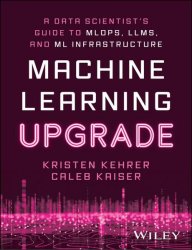 Название: Machine Learning Upgrade: A Data Scientist's Guide to MLOps, LLMs, and ML Infrastructure
Название: Machine Learning Upgrade: A Data Scientist's Guide to MLOps, LLMs, and ML InfrastructureАвтор: Kristen Kehrer, Caleb Kaiser
Издательство: Wiley
Год: 2024
Страниц: 237
Язык: английский
Формат: True/Retail PDF, True EPUB
Размер: 10.75 MB
A much-needed guide to implementing new technology in workspaces.
From experts in the field comes Machine Learning Upgrade: A Data Scientist's Guide to MLOps, LLMs, and ML Infrastructure, a book that provides data scientists and managers with best practices at the intersection of management, large language models (LLMs), Machine Learning, and Data Science. This groundbreaking book will change the way that you view the pipeline of Data Science. The authors provide an introduction to modern Machine Learning, showing you how it can be viewed as a holistic, end-to-end system―not just shiny new gadget in an otherwise unchanged operational structure. By adopting a data-centric view of the world, you can begin to see unstructured data and LLMs as the foundation upon which you can build countless applications and business solutions. This book explores a whole world of decision making that hasn't been codified yet, enabling you to forge the future using emerging best practices.
We intend this book to be something you can read all the way through. This is not an index of methods or a comprehensive book on machine learning. Our aim is to cover the challenges associated with modern-day machine learning with a particular focus on data versioning, experiment tracking, post-production model monitoring, and deployment to equip you with the code and examples to start leveraging best practices immediately.
Chapter 1 lays the groundwork, revealing how the workflow for managing machine learning has evolved from traditional, more linear frameworks for data science like CRISP-DM to the advent of language model-powered applications, or large language models (LLMs). We set the stage by emphasizing the need for a unified framework that hints at the thrilling path ahead—building an LLM-powered application together.
As we delve into Chapter 2, prepare to witness an end-to-end approach to machine learning, exploring its life cycle, the principles of a production machine learning system and the core of our LLM application.
Chapter 3 zooms in on the data-centric view, emphasizing the role of data in modern ML. This is a hands-on chapter, where we create embeddings and harness the power of vector databases for text similarity searches. We couple ethical guidelines and data versioning strategies to ensure a responsible and comprehensive approach.
Then comes Chapter 4, where we guide you through selecting the right LLM, leveraging LangChain, and fine-tuning LLM performance. With each part seamlessly connected, we venture into Chapter 5 to assemble our components and transition from prototype to application. We also demonstrate how to build dashboarding and application programming interfaces (APIs) to make your model results available to end users. But it doesn't stop there. Chapter 6 completes the ML life cycle, tackling model monitoring, retraining pipelines, and envisioning future deployment strategies and stakeholder communication.
Finally, in Chapter 7, we recap the best practices uncovered throughout this journey, explore emerging trends in LLMs, and provide resources for further learning.
This book is more than a guide—it's an adventure, an invitation to traverse the landscapes of modern machine learning, and an opportunity to equip yourself with the tools and knowledge to navigate it.
- Gain an understanding of the intersection between large language models and unstructured data
- Follow the process of building an LLM-powered application while leveraging MLOps techniques such as data versioning and experiment tracking
- Discover best practices for training, fine tuning, and evaluating LLMs
- Integrate LLM applications within larger systems, monitor their performance, and retrain them on new data
This book is indispensable for data professionals and business leaders looking to understand LLMs and the entire Data Science pipeline.
Скачать Machine Learning Upgrade: A Data Scientist's Guide to MLOps, LLMs, and ML Infrastructure